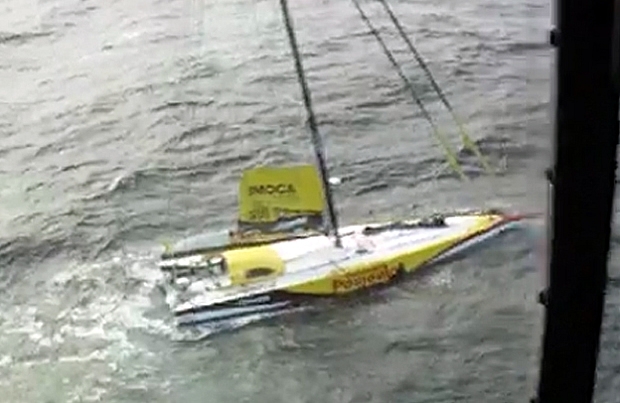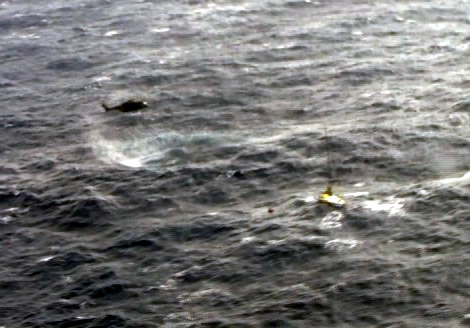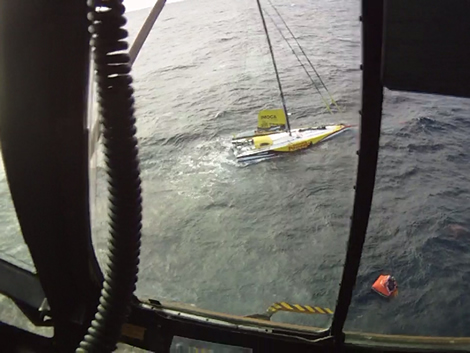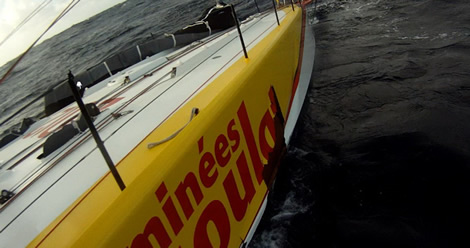Cheminees Poujoulat abandonment and recovery
The worst incident to befall boats in the Transat Jacques Vabre occurred to Bernard Stamm’s new Juan K-designed IMOCA 60 Cheminées Poujoulat.
Having held the lead, mid-evening on 6 November some 130 miles north of the Azores, Stamm and his co-skipper Jean-Francois Cuzon were about to go to the second reef and ORC in a building breeze, when Stamm went down below to discover the boat full of water. On inspection they discovered a hole in the hull just above the water line, ahead of the shrouds on the starboard side. They closed all the watertight hatches down below to contain the flood, emptied the main compartment with their bilge pump and collected all the necessary safety they would need should they have to abandon ship.
Stamm says he hoped they might be able to sail to the Azores the following morning. However when they hoisted the main with three reefs and a storm jib the boat was behaving erratically and with a considerable amount of water in the bow, the Swiss skipper was concerned about the safety of the boat. He considered organising a tow but in deteriorating conditions that would be unsafe, so he chose to set off his EPIRB at 09:50 UTC
“We couldn’t sail and it was very difficult to go anywhere,” Stamm recalled. “And the weather was not so good in the forecast. The sea was still very bad and I preferred to make the decision to switch on the beacon. After I was quite sure, because we could secure the boat, that we would be able to get the boat back.”
With the EPIRB triggered, so the search and rescue authorities leapt into action and with the rescue being co-ordinated through the MRCC Puna Delgada, so the Cheminées Poujoulat crew were airlifted off their stricken yacht by 1154 UTC.
Once ashore Stamm, Cuzon and the Cheminées Poujoulat team set about mounting a salvage attempt on their boat. With the help of boat captain Gautier Levisse and the head of the marina in Horta, Stamm managed to charter a 13.5m long fishing boat that should allow them to tow Cheminées Poujoulat to safety. They set out to sea on the afternoon of 9 November, the wind at this time still blowing 45 knots.
For just this eventuality, Cheminées Poujoulat was fitted with an ARGOS tracking beacon that was able to keep track of the location of the boat after her crew had left it. Unfortunately during the night there was concern among the crew when the ARGOS beacon stopped transmitting. Had the batteries in the beacon run out? Had their boat sunk?
From the last known position of the boat, they headed off downwind (to the east) and finally on the afternoon of 10 November, more than three days since they had left her, they located Cheminées Poujoulat, having first spotted her on the fishing boat’s radar. The boat was almost fully submerged with water up to her deck, Stamm recalled: “When we discovered the boat it was full of water, the same as BT, but it was not the coachroof, it was the deck panel and the companionway door that had gone. The first night when we left with the fishing boat we had very very bad weather, and I think that night was very damaging for the boat.” According to Stamm, before being airlifted off they had closed all the watertight hatches and the deck hatch and the companionway door and there was just a small amount of mainsail left hoisted.
Despite the rough conditions they launched the fishing boat’s small inflatable dinghy and Stamm and two of the fishing boat crew paddled across to the boat. After clambering on they put a towing line around the mast also fixing it to the bowsprit. “That was very dangerous, because there were still big waves and to fasten it to the front of the bowsprit, one time in the water, one time out of the water, etc - it was very acrobatic.”
They then began the long slow tow. Twice the towing line broke and had to be refastened. They had planned to go to Horta, but instead chose to go the shorter distance to the Azores Island of Teircera. 38 hours after they started the tow they arrived on the north side of the island pulling into the military port. Unfortunately they were unable to work on the boat there and with the wind having veered into the north nor were they able to move the boat to the island’s commercial port, so they were forced to wait there for 48 hours with the boat still submerged. Finally on 14 November the boat was moved, Cheminées Poujoulat was emptied of water and then lifted out, planted onto a make-shift cradle comprising four containers, and her mast taken out.
With the boat on land, it has since been examined by representatives of Juan Yacht Design and the Swiss builders at Decision and Stamm says that the concensus is that they hit an unidentified floating object. “The structure is not completely destroyed, just the panel where we hit the object. We have to rebuild that. This boat has been built to be very safe, so the crack didn’t extend further than the panel. The structure of the boat is okay and we have to analyse it some more. But all the systems are dead.”
Cheminées Poujoulat is shortly to leave on a ship to return to the team’s base in Brest, which will take five days to reach. Decision are already laminating up a new panel to replace the damaged part of the hull.
Of course pundits have been commenting on how the common thread between Cheminees Poujoulat's near loss and that of Seb Josse’s BT in more or less the same location in the 2009 Transat Jacques Vabre is co-skipper Jef Cuzon.
Stamm almost objects to this... “Sadly I have seen more bad situations than him. Every situation is different. We just do what we have to do in face of each situation. But he has experience of something I didn’t have which was to be picked up by a helicopter.” This is the third major disaster to befall Stamm after his keel loss in The Transat in 2004 off Newfoundland when once again he was able to salvage his boat but was unable to repair it in time for the Vendee Globe that year. During the last Vendee Globe he was in the process of heading for the Kerguelens to fix a rudder problem when he ran aground and his boat ended up being all but destroyed. Hopefully this being the third time, no further problems will befall him in next year’s Vendee Globe.
Stamm remains confident of being on the Vendee Globe start line in a year’s time. “We were afraid, very very unsure, when the beacon stopped to transmit the night before we arrived. But ws soon as we found the boat there was no question. We could rebuild it.” Repair work will begin at the end of the month and Cheminees Poujoulat has a full 2012 season ahead of her with the IMOCA class’ European tour in May and ultimately the Vendee Globe next autumn.















Latest Comments
Add a comment - Members log in